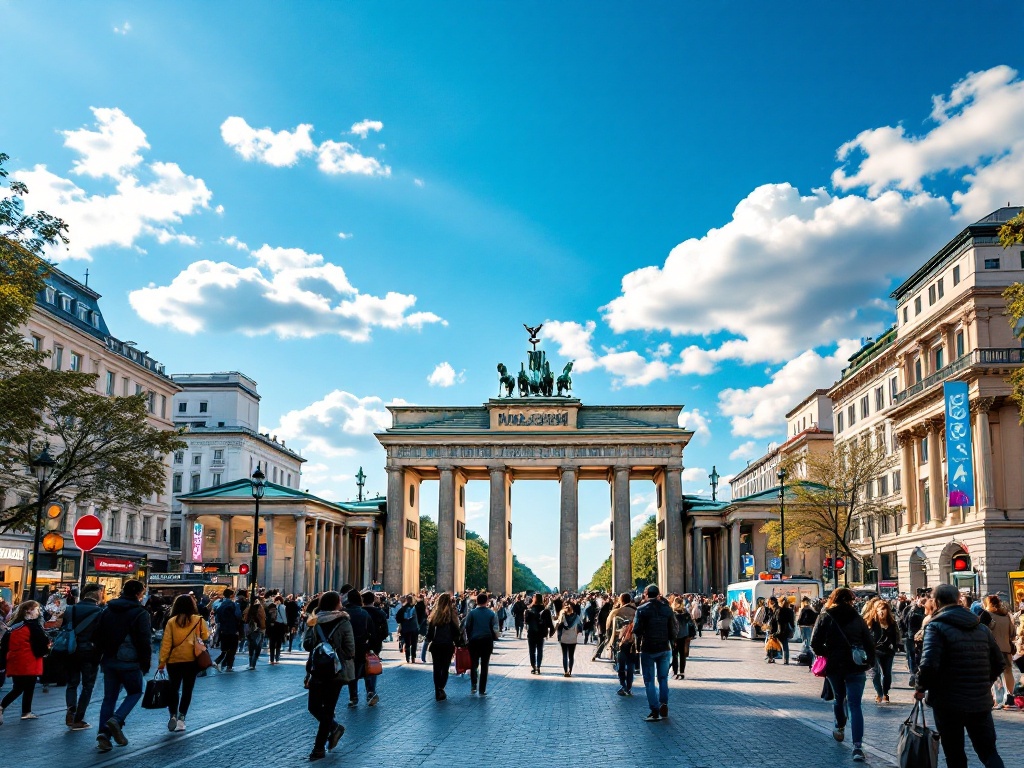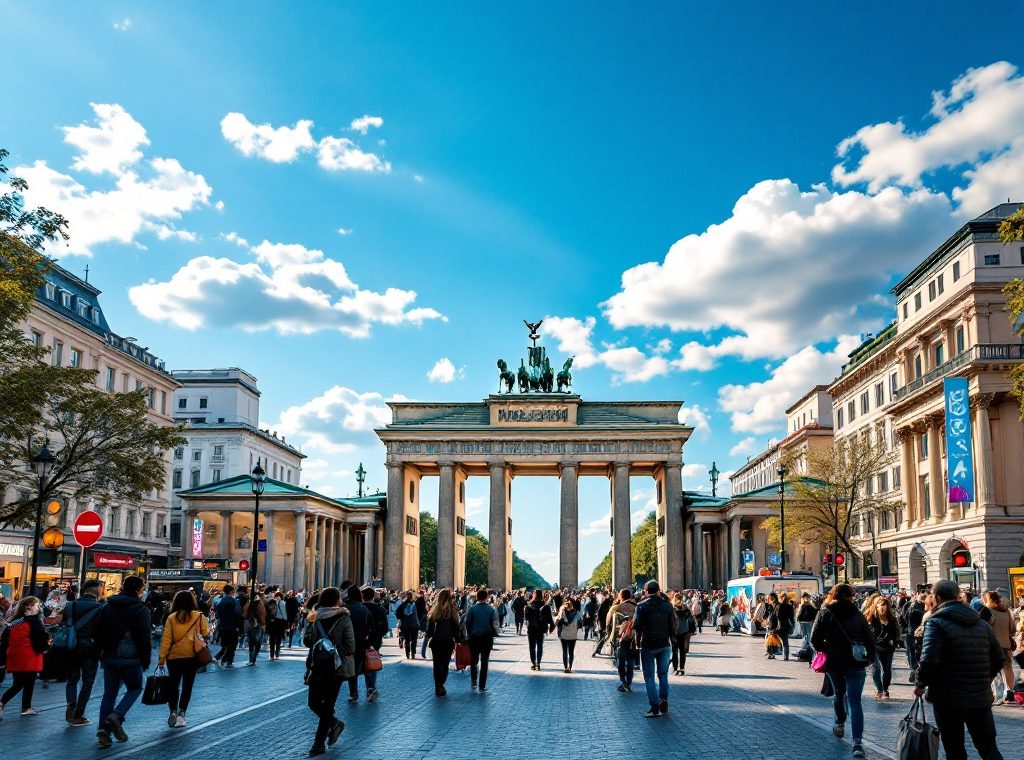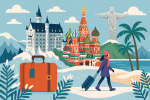Essential Travel Tips for First-Time Trips to Berlin
Discover Berlin, a vibrant city pulsing with history and culture! From iconic landmarks like the Brandenburg Gate to a thriving arts scene with over 150 museums, Berlin offers something for everyone. Learn how to navigate the city with ease using its accessible public transport, find the perfect accommodation to suit your budget, and plan your trip for the ideal time of year. Uncover insider tips for a smooth and unforgettable first trip to Berlin. Start planning your adventure today!
Important information

- Berlin’s main airport is Berlin Brandenburg Airport (BER), easily accessible to the city center by Airport Express train, regional trains, and buses.
- The city has a comprehensive public transport system (BVG) with U-Bahn (subway), S-Bahn (commuter rail), trams, and buses. Download the BVG app for navigation.
- Consider the Berlin WelcomeCard for free public transport and discounts at over 200 attractions.
- May and September are ideal times to visit, balancing pleasant weather with fewer crowds compared to the summer peak season.
- Carry cash, especially for smaller businesses and markets, although credit cards are widely accepted in larger establishments. Tipping 5-10% is customary.
Introduction to Berlin for First-Time Visitors
Berlin, Germany’s most popular tourist destination, captivates visitors with its rich history and over 150 museums. From historical sites for history buffs to a vibrant art scene for art lovers, the city truly offers something for everyone. Navigating Berlin is also easy, thanks to a variety of accessible transportation options, making it especially convenient for first-time visitors.
When to Visit Berlin
Shoulder Seasons (April-May & September-October)
Shoulder seasons offer the perfect blend of pleasant weather and fewer crowds. Enjoy comfortable temperatures ideal for exploring the city without the summer rush. Benefit from lower prices on accommodations and flights compared to the peak summer months.
Summer (June-August)
Summer is peak season, offering warm weather and long days, creating the perfect atmosphere for outdoor events, festivals, and enjoying the city’s parks, beer gardens, and open-air cinemas. Be aware of higher prices and increased tourism during these months.
Winter (November-March)
Experience a unique winter charm with colder temperatures and occasional snow. Explore charming Christmas markets, cozy cafes, and a vibrant indoor cultural scene. Take advantage of lower prices during the winter months.
Best Time to Visit
Berlin is best explored during the shoulder seasons—May to June and September to October—when the weather is pleasant and the crowds are thinner. While summer (July and August) bursts with outdoor activities and festivals, it also brings higher prices and a surge of tourists. For a sweet spot of comfortable temperatures and manageable queues, consider visiting in May or September.
Off-Peak Seasons
Experience Berlin’s charm in the pleasant weather of spring (March-May) or fall (September-October). Fewer crowds and lower hotel rates enhance your visit during these shoulder seasons, offering a delightful way to discover the city.
Getting to Berlin
Traveling to Berlin is easy, whether you prefer flying or taking the train. Fly into Berlin Brandenburg Airport (BER), the primary international airport, or arrive by train through Deutsche Bahn’s (DB) extensive rail network, connecting to major stations such as Berlin Hauptbahnhof and Berlin Ostbahnhof.
Arrival by Plane
Berlin Brandenburg Airport (BER) offers various ground transportation options, including taxis, buses, and the Airport Express train, which provides a direct connection to Berlin Hauptbahnhof for quick and convenient access to the city center.
Arrival by Train
Berlin has excellent train connections throughout Germany and Europe. Major stations like Hauptbahnhof, Ostbahnhof, Südkreuz, and Gesundbrunnen ensure easy rail access, regardless of your point of origin.
Arrival at Berlin Brandenburg Airport
Berlin Brandenburg Airport (BER) offers easy access to the city center with several transportation options. For a fast, direct route to Berlin Hauptbahnhof (Central Station), the Airport Express train is your best option. Regional trains provide access to other city stations and surrounding areas. The TXL Express bus and other bus services also connect BER to central Berlin.
Train Travel to Berlin
Traveling to Berlin by train is easy and convenient from many European cities. Deutsche Bahn (DB) and other major rail operators provide frequent high-speed rail connections. Berlin’s central stations include Hauptbahnhof, Gesundbrunnen, and Südkreuz. Booking tickets in advance, especially during peak season, is highly recommended to secure the best deals.
Accommodation Options in Berlin
Berlin offers diverse accommodations, from budget-friendly hostels to luxurious hotels. Guesthouses provide a cozy experience, while apartment rentals offer a home-away-from-home feel. For unique charm, consider a boutique hotel.
Choosing the Right Location
When selecting accommodations, consider these factors:
- Proximity to attractions.
- Ease of transportation.
- Preferred neighborhood vibe.
Explore Berlin’s Neighborhoods
Mitte: The city’s vibrant center, close to major landmarks.
Prenzlauer Berg: A more local, bohemian atmosphere.
Friedrichshain/Kreuzberg: Known for nightlife and an alternative scene.
Need help finding the perfect hotel? Share your preferences and budget, and we’ll find the ideal match for your Berlin adventure.
Where to Stay
Mitte, a must-see for history buffs, boasts iconic landmarks, museums, and historical sites. Prenzlauer Berg offers a different, bohemian atmosphere, complete with charming cafes and unique boutiques. For an edgier experience, Friedrichshain captivates with its alternative scene, vibrant street art, and exciting nightlife. Don’t miss the East Side Gallery while you’re there.
Charlottenburg exudes elegance, inviting you to stroll upscale streets, browse luxury shops, and admire grand palaces. Kreuzberg, a melting pot of cultures, offers diverse restaurants, bustling markets, and a truly unique experience. Similarly, Neukölln is another trendy spot, boasting a vibrant mix of cultures and exciting nightlife.
Hotel Recommendations
Berlin caters to every traveler’s budget, offering accommodations ranging from opulent luxury to budget-friendly options.
Luxury Stays
- Indulge in the Ritz-Carlton, Berlin, for an extravagant experience.
- Enjoy the lavish amenities at the Grand Hyatt Berlin.
- Experience history at the luxurious Hotel de Rome.
Budget-Friendly Options
- Embrace the trendy atmosphere of the Michelberger Hotel.
- Experience comfortable and affordable lodging at the Grand Hostel Berlin Classic.
- Enjoy stylish accommodations at the EastSeven Berlin Hostel.
Mid-Range Comfort
- Find tranquility and comfort at the Mandala Hotel.
- Experience the unique design of SO/ Berlin Das Stue.
- Enjoy the vibrant atmosphere of 25hours Hotel Bikini Berlin.
Getting Around Berlin
Berlin’s public transportation network (BVG) offers excellent city navigation. The U-Bahn (subway) is perfect for exploring the city center, while the S-Bahn (commuter rail) efficiently connects central Berlin to surrounding areas and beyond. Trams and buses supplement these, ensuring comprehensive city coverage. Alternatively, rent a bike for shorter journeys at your own pace. Taxis and ride-hailing services (Uber and Bolt) are also readily available.
Public Transportation: BVG System
Berlin’s extensive public transport system (BVG) seamlessly connects the city with U-Bahn, S-Bahn, trams, and buses. The U-Bahn (subway system) primarily operates underground. The S-Bahn (commuter rail network) links the city center to surrounding areas. Trams are common in East Berlin, providing convenient transport. Buses complete the network, reaching areas inaccessible by other means. This integrated system offers diverse travel options for everyone.
U-Bahn
Subway system operating primarily underground.
S-Bahn
Commuter rail network connecting the city center to surrounding areas.
Trams
Common in East Berlin, providing convenient transport.
Buses
Reach areas inaccessible by other means.
S-Bahn and U-Bahn Tips
Before boarding, validate your ticket. The U-Bahn operates primarily underground, while the S-Bahn runs above ground, connecting to the surrounding areas. For real-time updates and route planning, download the BVG app. If you travel frequently, consider a day or week pass for potential savings.
Biking and Bicycle Rentals
Berlin is a fantastic city to explore by bike, and rentals are readily available. Whether you need a bike for a day or a week, cycling offers a fun and efficient way to experience Berlin’s sights. So hop on two wheels and discover the city.
Taxis and Rideshares
Taxis are readily available. Ride-hailing services like Uber and Bolt offer convenient alternatives to public transportation. Public transport is generally the most economical choice.
Essential Travel Tips for First-Time Visitors
Planning your Berlin adventure? Secure your visa and travel insurance first. Book accommodations and transport early, especially during peak season. Use helpful apps like BVG for public transport and Google Translate. Learning basic German phrases will enhance your experience.
Money Matters
Carry small Euro coins for minor expenses, restrooms, and some ticket machines. While credit cards are widely accepted, cash is often preferred in smaller establishments and markets. Notify your bank of your travel dates to avoid card blockage.
Tipping Etiquette
Tipping is customary. In restaurants and bars, 5-10% is standard. Round up taxi fares or add a small amount. Tipping service staff, such as hotel porters and tour guides, is also appreciated.
Safety First
Stay aware of your surroundings, particularly in crowded areas. Secure your valuables and avoid displaying large sums of cash. Be cautious of overly friendly strangers. Report any suspicious activity to the police.
Respectful Interactions
Berliners appreciate directness and punctuality. Keep public conversations at a reasonable volume. Dress modestly at religious sites. Approach discussions about World War II and the Cold War with sensitivity.
Knowing basic German phrases like “Guten Tag,” “Danke,” and “Bitte” can greatly improve your interactions with locals. A translation app can assist with more complex communication.
Travel Preparation and Information
Research visa requirements and book your flights and accommodations.
Secure travel insurance.
Pack crucial documents, medications, and any necessary adapters.
Brush up on basic German phrases.
Download helpful apps like BVG for Berlin’s public transport and Google Translate for easy communication.
Familiarize yourself with local customs.
Notify your bank of your travel dates to avoid any card issues.
Make copies of important documents as a precaution.
Share your itinerary with a friend or family member back home for safety and peace of mind.
Carrying Cash and Euro Coins
While Berlin is a modern city, many shops, especially small businesses and street vendors, prefer cash. It’s helpful to carry euro coins for small purchases like public restrooms and snacks. Although credit cards are accepted in many places, cash remains the most common payment method.
Using Credit Cards and Cash
In Berlin, credit cards are widely accepted at major establishments like hotels, restaurants, and larger stores. However, it’s advisable to have some euros on hand for smaller shops, local markets, and some transportation. Carrying both credit cards and cash ensures a smooth and hassle-free experience.
Tipping Etiquette in Berlin
In Berlin, tipping 5-10% is customary for good service in restaurants and cafes. For smaller bills, rounding up or leaving small change is perfectly acceptable. For example, a €9.50 bill could easily become €10. However, for larger amounts, a 5-10% tip is more appropriate, with the option to leave a little extra for truly outstanding service.
Safety Tips and Avoiding Pickpocketing
In bustling areas like Alexanderplatz, Brandenburger Tor, and Potsdamer Platz, maintain awareness of your surroundings. Secure your belongings and consider using anti-theft bags or wallets for added protection. Avoid displaying large amounts of cash to minimize the risk of theft.
Cultural Etiquette and Sensitive Topics
When discussing German history, approach conversations about World War II and the Holocaust with particular sensitivity, acknowledging the immense suffering caused by these events. Avoid trivializing their significance, and always choose your words thoughtfully and respectfully.
Essential German Phrases
Brush up on some basic German phrases to enhance your travel experience. Use “Guten Morgen” (good morning), “Guten Tag” (good day), or “Guten Abend” (good evening) as appropriate. “Hallo” (hello) is suitable anytime.
Politeness is key. “Danke” (thank you) and “Bitte” (please/you’re welcome) are essential. Use “Entschuldigung” (excuse me) to navigate crowds or get attention.
Need help? Ask “Sprechen Sie Englisch?” (Do you speak English?). “Ja” (yes) and “Nein” (no) are your basic responses. When ordering food, begin with “Ich hätte gern…” (I would like…).
Find your way around by asking “Wo ist…?” (where is…?). Knowing these simple phrases can significantly improve your German adventures.
Travel Hacks and Insider Advice
Explore Berlin effortlessly with the Berlin WelcomeCard, offering complimentary public transportation and discounts on attractions. A well-planned itinerary will maximize your sightseeing, allowing you to experience the city’s diverse offerings. Berlin’s accessibility ensures that travelers with disabilities can navigate the city easily, thanks to a thoughtfully designed transport system and infrastructure. The Berlin WelcomeCard offers free public transport. You can also get discounts on major attractions. Create a personalized itinerary to make the most of your trip and explore Berlin’s diverse offerings. Berlin is also accessible for travelers with disabilities, with adapted transport and infrastructure.
Using the Berlin Welcome Card
Explore Berlin with the Berlin Welcome Card, offering unlimited public transport access throughout zones ABC, including Berlin Brandenburg Airport. Enjoy at least 25% off at over 200 attractions, ranging from museums and historical sites to tours, theaters, and restaurants. Choose a card duration from 48 hours to 6 days. For exploring Museum Island, a specialized pass grants entry to all its state museums. This pass is essential for convenient and cost-effective travel and sightseeing in Berlin.
Creating a Berlin Itinerary
Explore iconic landmarks: berlin boasts iconic landmarks like the Brandenburg Gate, the Reichstag Building, and the poignant East Side Gallery.
Organize your itinerary: consider organizing your itinerary around a theme, such as history, art, or culture, grouping nearby attractions to save travel time.
Plan for lines and time: allocate ample time at each site due to potential long lines and check opening hours and ticket prices in advance.
Plan your travel: utilize public transport or alternative methods for travel between locations.
Factor in breaks and meals: don’t forget to factor in breaks and meals throughout your day.
Stay flexible: remain flexible and adjust your itinerary as needed.
Consider a guided tour: a guided walking tour can enrich your experience with historical context.
Download a navigation app: downloading a navigation app with offline access will prove invaluable.
Accessibility and Getting Around
Berlin’s public transportation system prioritizes accessibility, featuring ramps, elevators, and designated spaces on buses and trains. This thoughtful design simplifies travel for all riders. For specific accessibility details regarding stations and transport modes, consult the BVG (Berliner Verkehrsbetriebe) website. Their journey planner is another excellent resource, helping you discover accessible routes across the city.














